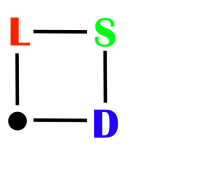Lattice simulation beyond the Standard Model
Lattice simulations are most suited for the study of strongly-coupled field theories, which possess asymptotic freedom: the interaction strength of the theory vanishes at extremely short distance scales. This property allows the connection of the lattice to the continuum through perturbation theory.
As a result, most lattice work up to this point has focused on the only known example in nature of a theory with asymptotic freedom, quantum chromodynamics (QCD).
However, there are a number of theoretical models of possible physics beyond the Standard Model that incorporate strong dynamics. Technicolor, topcolor, and composite Higgs are all examples of models involving new strong interactions (for more details on the physics, see the excellent PDG review on dynamical EW symmetry breaking.)
With the LHC about to come online, it is crucial to gain a solid theoretical understanding of these theories, in order to recognize their signatures should they appear in the LHC data. Unfortunately, investigation of strongly-coupled field theories using perturbative methods is challenging. This is a great opportunity for the lattice!
Wisdom obtained from the study of QCD can be used in some cases, but despite being strongly-interacting, any new physics may be sharply different from QCD in other ways. Indeed, some deviation from QCD-like behavior is required - theories that are too QCD-like tend to have problems with violation of existing precision electroweak experimental bounds, such as the S-parameter (see for example Peskin & Takeuchi, Phys. Rev. D46:381-409, 1992.)
The conformal window
Actually, we already know from perturbative studies that a strongly-interacting field theory can look very different from QCD.
One of the more well-known properties of QCD is confinement, the property that there are no color-singlet states; in terms of the coupling constant, the interaction strength diverges at long distances, forcing color-charged particles to bind together.
QCD has two “light” quarks, the up and down - so called because compared to typical energy scales relevant for a QCD interaction, they are essentially massless. The number of light quarks determines the behavior of the running coupling, through the beta-function. If many light quark flavors are introduced, just below the limiting value of 16.5 beyond which asymptotic freedom is lost, the infrared behavior of the theory looks very different, with the coupling strength flowing to a fixed point (see e.g. Banks & Zaks, Nucl. Phys. B196:189, 1982.)
At some point between 2 and 16 light flavors, there must be a critical value of the number of flavors Nf at which the transition from infrared-confining to infrared-conformal behavior takes place. Theories with more than the critical number of flavors, but less than 16.5, are said to lie in the conformal window. For the purposes of building explicit models, knowing the extent of the conformal window and the nature of the transition are invaluable.
Although there have been several attempts in the past to determine the extent of the conformal window, the first definitive step was taken by our previous trailblazing study at 8 and 12 flavors (Appelquist, Fleming and Neil - PRL 100:171607 2008.) We measured the Schrodinger Functional running coupling (see Simulation Details) in each theory, looking for either confinement or conformal behavior in the far infrared. We found that the 8-flavor theory showed no evidence of conformal behavior, while the 12-flavor result was consistent with an infrared fixed point.
Next stop: walking?
With the edge of the conformal window with fundamental fermions established to be between 8 and 12 flavors, the natural next step is to refine that estimate by simulating at 10 flavors. Beyond simply narrowing down the location of the conformal transition, the 10-flavor theory may be interesting in its own right. If it falls within the conformal window, it would provide yet another concrete example of an approximately conformal theory.
More interesting is the possibility that 10 flavors may lie just outside the conformal window. There is some speculation that such a theory could show conformal behavior at intermediate scales before finally confining far in the infrared. The existence of such a conformal plateau between the ultraviolet and infrared scales is referred to as “walking”, as the running coupling evolves very slowly in this region. A walking theory possesses a natural separation of scales; this separation gives much more room for model-builders to propose interesting new physics without running afoul of precision electroweak experiments.
